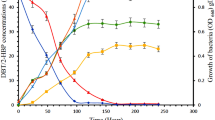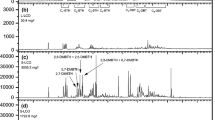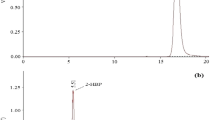Abstract
One of the main precursors of air pollution and acid rains is the presence of the recalcitrant thiophenic compounds, for example dibenzothiophene (DBT) and its derivatives in transportation fuels. In an attempt to achieve the worldwide regulations of ultra-low sulfur transportation fuels without affecting its hydrocarbon skeleton, a biphasic medium containing 100 mg/L DBT dissolved in n-hexadecane (1/4 oil/water v/v) used for enrichment and isolation of selective biodesulfurizing bacterium from an oil-polluted sediment sample collected from Egyptian Red Sea shoreline. The isolated bacterium is facultative anaerobe, motile, spore-former, and mesophile. It is genetically identified as Paenibacillus glucanolyticus strain HN4 (NCBI Gene Bank Accession No. MT645230). HN4 desulfurized DBT as a model of the recalcitrant thiophenic compounds without affecting its hydrocarbon skeleton via the 4S-pathway producing 2-hydroxybiphenyl (2-HBP) as a dead end product. HN4 substantiated to be a hydrocarbon tolerant, biosurfactants(s) producer, and endorsed unique enzymatic system capable of desulfurizing broad range of thiophenic compounds and expressed an efficient desulfurization activity against the recalcitrant alkylated DBTs. As far our knowledge, it is the first reported BDS study using P. glucanolyticus. Statistical optimization based on One-Factor-At-A-Time (OFAT) technique and response surface methodology (RSM) applied for elucidation of mathematical model correlations describing and optimizing the effect of different physicochemical parameters on batch biphasic BDS process. That illustrated an approximate increase in BDS efficiency by 1.34 fold and recorded 94% sulfur removal in biphasic batch process at optimum operation conditions of 120 h, 0.14 wt% S-content model oil (DBT dissolved in n-hexadecane), 33.5 °C, pH7 and 1/1 oil/water phase ratio, and 147 rpm. Resting cells of HN4 in a biphasic reactor (1/1 v/v) decreased the sulfur content of a refractory thiophenic model oil (thiophene, benzothiophene, DBT, and alkylated DBT dissolved in n-hexadecane) from 0.14 to 0.027 wt%, and petro-diesel from 0.2 to 0.04 wt%, within 120 h, keeping the calorific value of the treated fuel intact. Consequently, that novel strain could be recommended as a promising candidate for BDS as complementary to hydrodesulfurization process in oil refinery.







Similar content being viewed by others
Data availability
All data generated or analysed during this study are included in this published article.
References
Abid MF, Ahmed SM, AbuHamid WH, Ali SM (2019) Study on novel scheme for hydrodesulfurization of middle distillates using different types of catalyst. J King Saud Univ Eng Sci 31:144–151
Abin-Fuentes A, Leung J, Mohamed M, Wang D, Prather K (2014) Rate-limiting step analysis of the microbial desulfurization of dibenzothiophene in a model oil system. Biotechnol Bioeng 111(5):876–884
Acero J, Berdugo C, Mogollón L (2003) Biodesulfurization process evaluation with a Gordona rubropertinctus strain. CT F Cienc Tecnol Futuro 2(4):43–54
Agarwal P, Sharma DK (2010) Comparative studies on the biodesulfurization of crude oil with other desulfurization techniques and deep desulfurization through integrated processes. Energy Fuel 24(1):518–524
Akhtar N, Akhtar K, Ghauri MA (2018) Biodesulfurization of thiophenic compounds by a 2-hydroxybiphenyl-resistant Gordonia sp. HS126-4 N carrying dszABC genes. Curr Microbiol 75:597–603
Alcon A, Santos VE, Martin AB, Yustos P, Garcia-Ochoa F (2005) Biodesulfurization of DBT with pseudomonas putida CECT5279 by resting cells influence of cell growth time on reducing equivalent concentration and Hpac activity. Biochem Eng 26:168–175
Ali HR, Ismail DA, El-Gendy NS (2014) The biotreatment of oil-polluted seawater by biosurfactant producer halotolerant Pseudomonas aeruginosa Asph2. Energ Source Part A 36:1429–1436
Amin GA, Bazaid SA, El-Halim MA (2013) Two-stage immobilized cell bioreactor with Bacillus subtilis and Rhodococcus erythropolis for the simultaneous production of biosurfactant and biodesulfurization of model oil. Pet Sci Technol 31(21):2250–2257
ASTM D240 – 19 “Standard test method for heat of combustion of liquid hydrocarbon fuels by bomb calorimeter”.
ASTM D4294 - 03 “Standard test method for sulfur in petroleum and petroleum products by energy-dispersive X-ray fluorescence spectrometry”.
Bahuguna A, Lily MK, Munjal A, Singh RN, Dangwal K (2011) Desulfurization of dibenzothiophene (DBT) by a novel strain Lysinibacillus sphaericus DMT-7 isolated from diesel contaminated soil. J Environ Sci 23(6):975–982
Bailey JE, Ollis DF (1986) Biochemical engineering fundamental 2nd ed. McGraw-Hill, New York, USA
Barrios SMY (2011) Bioremediation: a tool for the management of oil pollution in marine ecosystems. Biotecnol Apl 28:69–76
Bhanjadeo MM, Rath K, Gupta D, Pradhan N, Biswal SK, Mishra BK, Subudhi U (2018) Differential desulfurization of dibenzothiophene by newly identified MTCC strains: influence of operon array. PLoS One 13(3):e0192536. https://doi.org/10.1371/journal.pone.0192536
Bordoloi NK, Rai SK, Chaudhuri MK, Mukherjee AK (2014) Deep-desulfurization of dibenzothiophene and its derivatives present in diesel oil by a newly isolated bacterium Achromobacter sp. to reduce the environmental pollution from fossil fuel combustion. Fuel Process Technol 119:236–244
Calzada J, Zamarro MT, Alcón A (2009) Analysis of dibenzothiophene desulfurization in a recombinant pseudomonas putida strain. Appl Environ Microbiol 75(3):875–877
Canales C, Eyzaguirre J, Baeza P, Aballay P, Ojeda J (2018) Kinetic analysis for biodesulfurization of dibenzothiophene using R. rhodochrous adsorbed on silica. Ecol Chem Eng S 25(4):549–556
Caro A, Boltes K, Leton P, García-Calvo E (2008) Biodesulfurization of dibenzothiophene by growing cells of Pseudomonas putida CECT 5279 in biphasic media. Chemosphere 73:663–669
Caro A, Boltes K, Letón P, García-Calvo E (2007) Dibenzothiophene biodesulfurization in resting cell conditions by aerobic bacteria. Biochem Eng J 35:191–197
Chen S, Zhao C, Liu Q, Zang M, Liu C, Zhang Y (2018) Thermophilic biodesulfurization and its application in oil desulfurization. Appl Microbiol Biotechnol 102:9089–9103
Chen S, Zhao C, Liu Q, Zhang X, Sun S, Zang M (2019) Biodesulfurization of diesel oil in oil–water two phase reaction system by Gordonia sp. SC-10. Biotechnol Lett 41:547–554
Davoodi-Dehaghani F, Vosoughi M, Ziaee AA (2010) Biodesulfurization of dibenzothiophene by a newly isolated Rhodococcus erythropolis strain. Bioresour Technol 101:1102–1105
Derikvand P, Etemadifar Z, Saber H (2015) Sulfur removal from dibenzothiophene by newly isolated Paenibacillus validus strain PD2 and process optimization in aqueous and biphasic (model-oil) systems. Pol J Microbiol 64(1):47–54
Dinamarca MA, Rojas A, Baeza P, Espinoza G, Ibacache-Quiroga C, Ojeda J (2014) Optimizing the biodesulfurization of gas oil by adding surfactants to immobilized cell systems. Fuel 116:237–241
El-Gendy NS, Nassar HN, Abu Amr SS (2014) Factorial design and response surface optimization for enhancing a biodesulfurization process. Pet Sci Technol 32(14):1669–1679
El-Gendy NS, Nassar HN (2015) Kinetic modeling of the bioremediation of diesel oil polluted seawater using Pseudomonas aeruginosa NH1. Energ Source Part A 37(11):1147–1163
Folsom BR, Schieche DR, Digrazia PM, Werner J, Palmer S (1999) Microbial desulfurization of alkylated dibenzothiophenes from a hydrodesulfurized middle distillate by Rhodococcus erythropolis I-19. Appl Environ Microbiol 65(11):4967–4972
Furuya T, Kirimura K, Kino K, Usami S (2001) Thermophilic biodesulfurization of dibenzothiophene and its derivatives by Mycobacterium Phlei WU-F1. FEMS Microb Lett 24:129–133
Ghafari S, Baboli Z, Neisi A, Mirzaee SA, Soltani RDC, Saeedi R, Abtahi M, Jorfi S (2019) Surfactant-enhanced bioremediation of n-hexadecane-contaminated soil using halo-tolerant bacteria Paenibacillus glucanolyticus sp. strain T7-AHV isolated from marine environment. Chem Biochem Eng Q 33(1):111–123
Gunam IBW, Yaku Y, Hirano M (2006) Biodesulfurization of alkylated forms of dibenzothiophene and benzothiophene by Sphingomonas subarctica T7b. J Biosci Bioeng 101:322–327
Heidarinasab A, Soltanieh M, Ardjmand M, Ahmadpanahi H, Bahmani M (2016) Comparison of Mo/MgO and Mo/ɣ-Al2O3 catalysts: impact of support on the structure and dibenzothiophene hydrodesulfurization reaction pathways. Int J Environ Sci Technol 13:1065–1076
Ismail W, El-Said W, Raheem ASA, Mohamed ME, El Nayal AM (2016) Biocatalytic desulfurization capabilities of a mixed culture during non-destructive utilization of recalcitrant organosulfur compounds. Front Microbiol 7:1–14
Kaufman EN, Harkins JB, Borole AP (1998) Comparison of batchstirred and electrospray reactors for biodesulfurization of dibenzothiophene in crude oil and hydrocarbon feedstocks. Appl Biochem Biotechnol 73(2/3):27–144
Kawaguchi H, Kobayashi H, Sato K (2012) Metabolic engineering of hydrophobic Rhodococcus opacus for biodesulfurization in oil-water biphasic reaction mixtures. J Biosci Bioeng 113:360–366
Kim YJ, Chang JH, Cho K, Ryu HW, Chang YK (2004) A physiological study on growth and dibenzothiophene (DBT) desulfurization characteristics of Gordonia sp. CYKS1. Korean J Chem Eng 21:436–441
Kobayashi M, Horiuchi K, Yoshikawa O, Hirasawa K, Ishii Y, Fujino K, Sugiyama H, Maruhashi K (2001) Kinetic analysis of microbial desulfurization of model and light gas oils containing multiple alkyl debenzothiophenes. Biosci Biotechnol Biochem 65(2):298–304
Kobayashi M, Onaka T, Ishii Y, Konishi J, Takaki M, Okada H, Ohta Y, Koizumi K, Suzuki M (2000) Desulfurization of alkylated forms of both dibenzothiophene and benzothiophene by a single bacterial strain. FEMS Microbiol Lett 87:123–126
Konishi J, Ishii Y, Onaka T, Okumura K, Suzuki M (1997) Thermophilic carbon-sulfur-bond-targeted biodesulfurization. Appl Environ Microbiol 63(8):3164–3169
Konishi J, Onaka T, Ishii Y, Suzuki M (2000) Demonstration of the carbon-sulfur bond targeted desulfurization of benzothiophene by thermophilic Paenibacillus sp. strain A11-2 capable of desulfurizing dibenzothiophene. FEMS Microbiol Lett 187:151–154
Lateef SA, Ajumobi OO, Onaiz SA (2019) Enzymatic desulfurization of crude oil and its fractions: a mini review on the recent progresses and challenges. Arab J Sci Eng 44:5181–5193
Lee HK, Khaine I, Kwak MJ, Jang JH, Lee TY, Lee JK, Kim IR, Kim WI, Oh KS, Woo SY (2017) The relationship between SO2 exposure and plant physiology: a mini review. Hortic Environ Biotechnol 58(6):523–529
Li F, Xu P, Feng J, Meng L, Zheng Y, Luo L, Ma C (2006) Microbial desulfurization of gasoline in a Mycobacterium goodii X7B immobilized-cell system. Appl Environ Microbiol 71:276–281
Li W, Jiang X (2013) Enhancement of bunker oil biodesulfurization by adding surfactant. World J Microbiol Biotechnol 29:103–108
Luo MF, Xing JM, Gou ZX, Li S, Liu HZ, Chen JY (2003) Desulfurization of dibenzothiophene by lyophilized of Pseudomonas delafieldii R-8 in the presence of dodecane. Biochem Eng J 13:1–6
Maass D, Todescato D, Moritz DE, Oliveira JV, Oliveira D, Ulson de Souza AA, Guelli Souza SM (2015) Desulfurization and denitrogenation of heavy gas oil by Rhodococcus erythropolis ATCC 4277. Bioprocess Biosyst Eng 38:1447–1453
Martínez I, Mohamed ME, Rozas D, García JL, Díaz E (2016) Engineering synthetic bacterial consortia for enhanced desulfurization and revalorization of oil sulfur compounds. Metab Eng 35:46–54
Matsubara TT, Ohshiro T, Nishina Y, Izumi Y (2001) Purification, characterization, and over expression of flavin reductase involved in dibenzothiophene desulfurization by Rhodococcus erythropolis D-1. Appl Environ Microbiol 67:1179–1184
Mohamed ME, Al-Yacoub ZH, Vedakumar JV (2015) Biocatalytic desulfurization of thiophenic compounds and crude oil by newly isolated bacteria. Front Microbiol 6:112. https://doi.org/10.3389/fmicb.2015.00112
Monticello DJ (2000) Biodesulfurization and the upgrading of petroleum distillates. Curr Opin Biotechnol 11:540–546
Monticello DJ, Kilbane JJ (1994). Microemulsion process for direct biocatalytic desulfurization of organosulfur molecules. US Patent 5,358,870.
Nakashima N, Tamur T (2004) A novel system for expressing recombinant proteins over a wide temperature range from 4 to 35°C. Biotechnol Bioeng 86:136–148
Nassar HN, Deriase SF, El-Gendy NS (2017) Statistical optimization of biomass production and biodesulfurization activity of Rhodococcus erythropolis HN2. Pet Sci Technol 35(20):1951–1959
Nassar HN, El-Gendy NS, Abo-State MA, Mostafa YM, Mahdy HM, El-Temtamy SA (2013) Desulfurization of dibenzothiophene by a novel strain Brevibacillus invocatus C19 isolated from Egyptian coke. Biosci Biotechnol Res Asia 10(1):29–46
Ohshiro T, Hirata T, Hashimoto I, Izumi Y (1996) Characterization of dibenzothiophene desulfurization reaction by whole cells of Rhodococcus erythropolis H-2 in the presence of hydrocarbon. J Ferment Bioeng 82:610–612
Ohshiro T, Nakura S, Ishii Y, Kino K, Kirimura K, Izumi Y (2009) Novel reactivity of dibenzothiophene monooxygenase from Bacillus subtilis WU-S2B. Biosci Biotechnol Biochem 73:2128–2130
Onaka T, Konishi J, Ishii Y, Maruhashi K (2001) Desulfurization characteristics of thermophilic Paenibacillus sp. strain A11-2 against asymmetrically alkylated dibenzothiophenes. J Biosci Bioeng 92(2):193–196
Porto B, Maass D, Oliveira JV, de Oliveira D, Yamamoto CI, Ulson de Souza AA, Ulson de Souza SMAG (2018) Heavy gas oil biodesulfurization using a low-cost bacterial consortium. J Chem Technol Biotechnol 93:2359–2363
Sadare OO, Obazu F, Daramola MO (2017) Biodesulfurization of petroleum distillates—current status, opportunities and future challenges. Environments 4:85. https://doi.org/10.3390/environments4040085
Sharma R, Singh J, Verma N (2020) A novel spectrophotometric method for simultaneous estimation of dibenzothiophene and 2-hydroxybiphenyl in their mixed spectrum and its application in screening of specific biodesulfurizing microbes. 3 Biotech 10:153 https://doi.org/10.1007/s13205-020-2138-1.
Setti L, Lanzarini G, Pifferi PG (1995) Dibenzothiophene biodegradation by a Pseudomonas sp. in model solutions. Process Biochem 30(8):721–728
Soleimani M, Bassi A, Margaritis A (2007) Sulfur compounds in fossil fuels. Biotechnol Adv 25(6):570–596
Su T, Su J, Liu S, Zhang C, He J, Huang H, Xu S, Gu L (2018) Structural and biochemical characterization of BdsA from Bacillus subtilis WU-S2B, a key enzyme in the “4S” desulfurization pathway. Front Microbiol 9:231. https://doi.org/10.3389/fmicb.2018.00231
Tanaka Y, Matsui T, Konishi J, Maruhashi K, Kurane R (2002) Biodesulfurization of benzothiophene and dibenzothiophene by a newly isolated Rhodococcus strain. Appl Microbiol Biotechnol 59:325–328
Tao F, Liu Y, Luo Q, Su F, Xu Y, Li F, Yu B, Ma C, Xu P (2011) Novel organic solvent-responsive expression vectors for biocatalysis: application for development of an organic solvent-tolerant biodesulfurizing strain. Bioresour Technol 102:9380–9387
Tao F, Yu B, Xu P, Ma CQ (2006) Biodesulfurization in biphasic systems containing organic solvents. Appl Environ Microbiol 72:4604–4609
Wang J, Davaadelger B, Salazar JK, Butler RR III, Pombert J-F, Kilbane JJ, Stark BC (2015) Isolation and characterization of an interactive culture of two Paenibacillus species with moderately thermophilic desulfurization ability. Biotechnol Lett 37:2201–2211
Zhang S-H, Chen H, Li W (2013) Kinetic analysis of biodesulfurization of model oil containing multiple alkyl dibenzothiophenes. Appl Microbiol Biotechnol 97:2193–2200
Author information
Authors and Affiliations
Contributions
HNN conducted the isolation of the bacteria and its identification, all the microbiological and biodesulfurization experiments, all the analysis to follow up the biodesulfurization efficiency, and the kinetic analysis and its validation. SSA performed the statistical analysis. NShE conceived and designed the research, interpreted, analysed, and discussed the obtained data and wrote the manuscript, and all authors commented on previous versions of the manuscript. Finally, all authors read and approved the manuscript.
Corresponding author
Ethics declarations
Conflicts of interest
The authors declare that they have no competing interests.
Ethics approval and consent to participate
Not applicable
Consent for publication
Not applicable
Additional information
Responsible Editor: Robert Duran
Publisher’s note
Springer Nature remains neutral with regard to jurisdictional claims in published maps and institutional affiliations.
Rights and permissions
About this article
Cite this article
Nassar, H.N., Abu Amr, S.S. & El-Gendy, N.S. Biodesulfurization of refractory sulfur compounds in petro-diesel by a novel hydrocarbon tolerable strain Paenibacillus glucanolyticus HN4. Environ Sci Pollut Res 28, 8102–8116 (2021). https://doi.org/10.1007/s11356-020-11090-7
Received:
Accepted:
Published:
Issue Date:
DOI: https://doi.org/10.1007/s11356-020-11090-7




